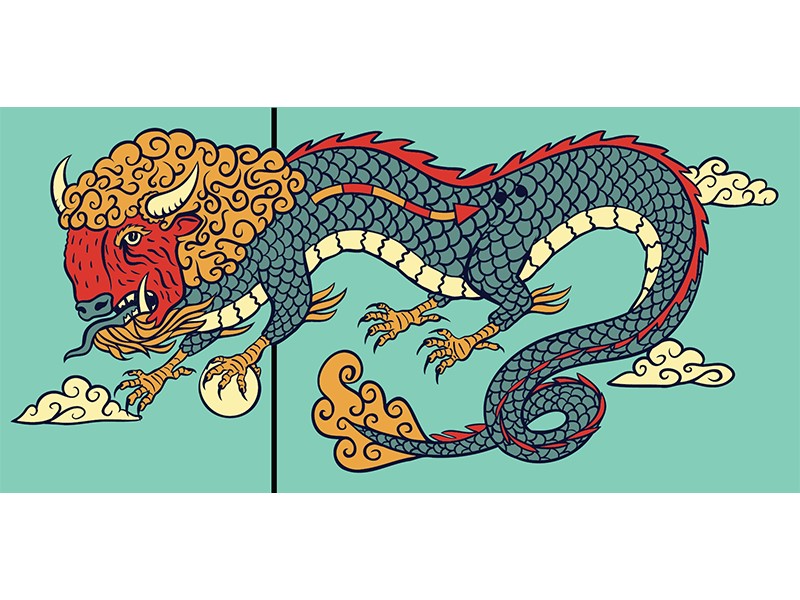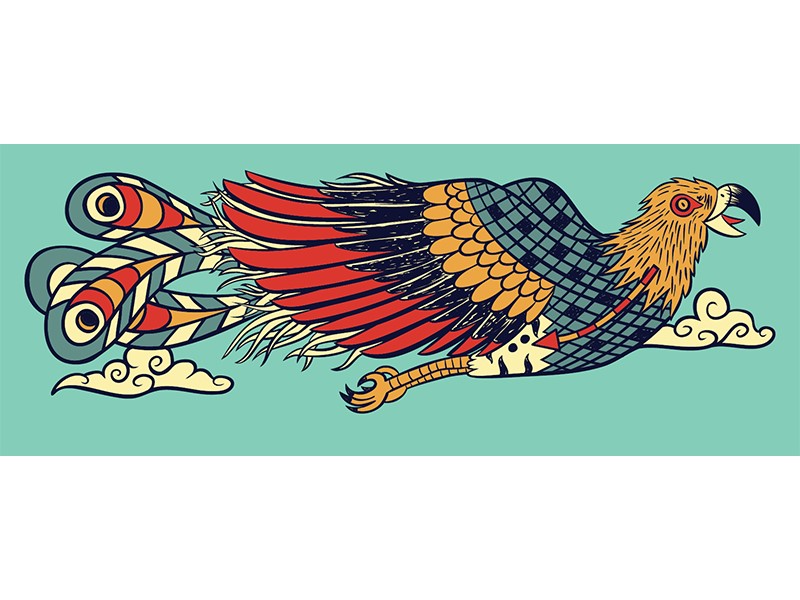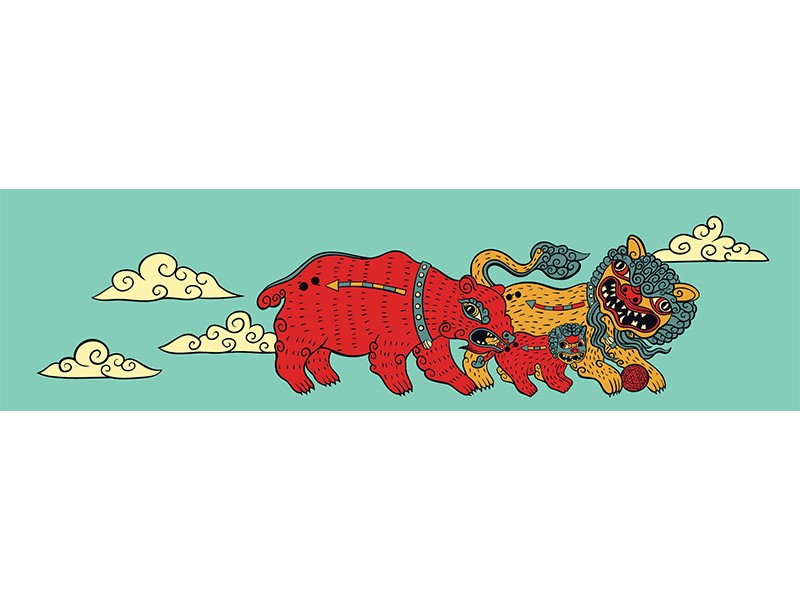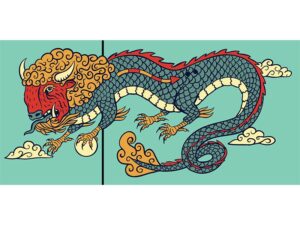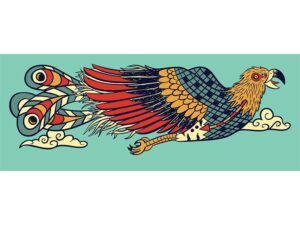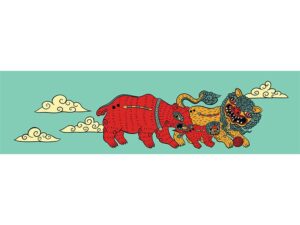The Project
This public art project in Chinatown represents a history of collaboration and shared adversity between local Chinese and Indigenous communities.
Designed by artist Jarett Sitter, this project is comprised of three wall-mounted panels, two on 1st St. SE and one at 4th Ave. SE. Each panel represents a fusion of animals important to both cultures: A Chinese dragon with the head of a bison, a phoenix with the head of a golden eagle and a lion and bear with their cub, which combines traits of both animals.
The intent of the project is to create a vibrant and engaging public artwork that celebrates the diversity of Mohkinsstsis/Calgary to be enjoyed by all motorists, pedestrians, businesses and residents in the area. The Bison and the Dragon: Untold Tales will be collected and maintained as part of the City of Calgary Public Art Collection for its lifespan.
Artist Statement
Stories are how we make sense of our surroundings, how we pass down our history and how we learn to live in the world. When important stories remain largely untold for too long, they disappear. The Bison and The Dragon: Untold Tales highlights the long, shared history between Chinese and Indigenous communities on this land. The series of three wall installations visually represents stories of connection, kinship and support that are less visible or less publicly known.
I am a mixed heritage artist of Chinese and Polish-German descent. The Bison and The Dragon: Untold Tales tells the story of co-operation and shared adversity within our Chinese community from my mixed/Chinese perspective. I was inspired by community stories about the friendships and relationships that formed between the first Chinese people who immigrated to the prairies and the Plains First Nations (the Niitsitapi, the Tsuut’ina Nation, and the Stoney Nakoda Nation). Stories of First Nations people who helped the Chinese community survive the harsh winter elements when, unlike their white counterparts, they were not permitted to sleep in the train cars at night while they were working on the railroad. Stories of Chinese people not being allowed to visit white doctors, but receiving care in First Nations communities, and stories of First Nations people being fed in Chinese cafés when they were not permitted in white establishments. I am also interested in stories of Chinese men marrying First Nations women in the early days of Chinese immigration, and the untold stories of their children. These are stories I was continually thinking of while creating this artwork, as someone who is also mixed race and existing between cultures.
In Chinese mythology, the dragon and phoenix are creatures made of several different animals. For example, a dragon is often thought of as being composed of nine different animals, some parts depicted being the head of a camel (other times a crocodile), the talons of an eagle, the belly of a clam. In my illustrated animals, I reference a traditional style of Chinese artwork and Chinese mythological creatures, while also introducing visual details and new animal elements meant to honour the First Nations people of Mohkinsstsis who are the original stewards of this land.
This public artwork displayed in the Chinatown community incorporates animals that are important to the Niitsitapi people, most notably the bison and the golden eagle. I have also made the addition of the lifeline, a visual element that represents the life force that runs through and connects all living things. This element was inspired by suggestions and information shared with me by Elders Cindy Daniels from Îyârhe Nakoda and Rod Scout from Siksika, whom I thank for their guidance in sharing their knowledge and stories.
By bringing together Chinese mythological creatures and animals/symbols that are important to the Niitsitapi people, I hope to form a new visual language and iconography that speaks not only to the relationship between the early Chinese community and the Plains First Nations, but also to my own experience of existing between two cultures. My hope is to give a louder voice to stories that have previously only been whispered.
Community Engagement:
January 2022: A joint project between the City of Calgary and Calgary Arts Development was announced, with the goal of creating a temporary road mural on 3rd Avenue, between Centre St. and 1 St. SE in Chinatown. The mural was planned to add visual interest to the area while construction was underway as part of the Eau Claire Area Improvements Program. The projected timeline would have the mural installed during the Summer of 2022.
February 2022: A Call to Artists was released, and by Spring 2022 a selection committee named local artist Jarett Sitter to design the road mural.
Spring 2022: Sitter and Calgary Arts Development staff began to meet with community members and collect feedback to inform the mural design. Members of the public were encouraged to submit feedback online, or as part of several in-person or video-conference events.
It was during this process of engagement that several Elder Chinese community members shared that painting on the road, where traffic and pedestrians would walk over the work, could be considered culturally insensitive to the community. The idea of a road mural was reminiscent of a cultural practice known as “Villain hitting,” which is the act of cursing a person by walking on a paper image of their likeness.
Taking this feedback into account, Sitter and Calgary Arts Development cancelled plans to paint a mural on the ground and began exploring alternative options. A new round of community engagement began, with local community leaders and Indigenous Elders giving inspiration and context for Jarett Sitter’s artwork.
Winter 2023: The project was changed to a series of temporary art panels, installed directly onto three walls within the community. Two walls on either side of Pho City and one wall on the rear of the Calgary Immigrant Women’s Association were selected, in agreement with both local building owners.
May 2023: Through two in-person events and an online social media campaign, Sitter’s concept was shared with the public.
July 2024 – mid-August 2024: Artwork fabrication
Mid-August to September 2024: Artwork installation
September 25, 2024: Project launch
A community celebration was held in Chinatown. People had an opportunity to meet the artist, learn about the artworks and enjoy lunch provided by local establishments.
